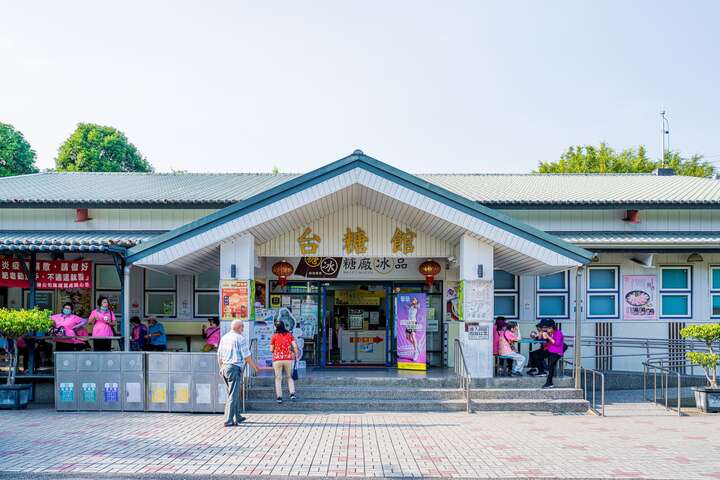Chiao-Tou Sugar Factory (Taiwan Sugar Museum) Introduction
With the selected package in Kaohsiung, you can easily enjoy the tranquility of Qiaotou, where the heart naturally finds peace. Step into the unique aesthetic thinking of Japan and explore historical relics such as the Qiaotou Factory Manager's Dormitory, experiencing the beauty of Japanese wabi-sabi through seasonal wagashi, Japanese tea, tea ceremonies, and floral art. Purchasing Information: The Qiaotou Sugar Factory, formerly known as "Qiaotou Sugar Factory," was Taiwan's first modern mechanical sugar factory, which was commissioned during the Japanese occupation in 1901 (Meiji 34). It once led Taiwan into the prosperous sugar era and set numerous records in the Taiwan sugar industry over the years. It was a pioneer in utilizing steel construction technology in the early days of Japanese occupation and is listed as a designated historical site by the city government. The preserved relics within the park include the sugar factory, Japanese wooden houses, air-raid shelters, and red-brick water towers. In 2006, Taiwan Sugar Corporation established the Taiwan Sugar Museum on site, preserving parts of the walls of the first sugar factory built a century ago and opening the entire sugar production facility to visitors, allowing them to experience the physical process of transporting, squeezing, purifying, evaporating, crystallizing, separating, and packaging sugarcane. Features of the Park: The park features both Japanese and Baroque-style tropical colonial architecture, along with 19 other historical sites, including red-brick water towers, ammunition depots, and a life-sized Guanyin statue, illustrating Taiwan's historical struggles for economic and industrial development. The rich public art creations and cultural exhibition spaces add a trendy cultural dynamism to the nostalgic environment. The expansive park also possesses abundant natural ecological resources, with birds, dragonflies, butterflies, and squirrels being frequent visitors. A stroll in the summer afternoon allows you to feel the gentle breeze, followed by a visit to the sales area to enjoy traditional ice products from Taiwan Sugar and take a five-minute ride, making it an excellent choice for family and friends. Factory Manager's Dormitory: Built in 1940, the Factory Manager's Dormitory was constructed by Kinmoku Sanzo, the manager of the Taiwan Sugar Company. It is currently the most well-preserved and representative Japanese-style dormitory within the factory area. Architectural features include a roof framework made of Taiwanese cypress, elevated floors, wooden bed frames, a front yard, a rear garden, and a Japanese-style water feature. Notably, it also features a rare independent brick foundation in Taiwanese Japanese-style dormitories. In 2011, Taiwan Sugar Corporation completed restoration according to the original style; from 2015 onwards, the external space has been open for visitors to explore and take photos, and the internal space also offers guided tours by appointment. The elegant appearance of this old Japanese house was chosen as one of the filming locations for the award-winning film "The Great Buddha+" at the 54th Golden Horse Awards, turning it into a popular spot for fans to visit and take photos. Social Housing Office: Built in 1901, this was one of the important constructions during the Japanese occupation. Its architectural structure combines wood, brick, and reinforced concrete, marking a significant project in Taiwanese architectural history. The exterior mimics the buildings of Dutch colonies in Southeast Asia, featuring elevated foundations for ventilation, corridors, and continuous arches that reflect European styles. Notably, the square holes surrounding the building are not for decoration but serve as gun ports for defense against bandit raids, making this site a popular social media check-in spot due to the film "The Great Buddha+". Qiaotou Sugar Factory Club: In 1902, the then president Suzuki Tokusaburo, empathizing with employees who came to Taiwan from Japan, established this club within the sugar factory to provide a gathering place for the colleagues who were far from home. The building primarily adopts a "tropical colonial style" complemented with Japanese wooden construction techniques. It is now planned as a sugar industry museum, café, and a museum of pig-related artifacts, with the "Pig Artifacts Museum" showcasing over 1,300 themed items donated by Professor Chen Shih-Meng from National Taiwan University and former director Ge Fu-Jiang from Taiwan Sugar Company's Animal Husbandry Research Institute. Rain Tree Square: Once a Japanese military shooting range during the occupation, in 1958, after Japan's defeat, the Nationalist government built dormitories for employees training Vietnamese exchange students behind the rain trees. Below the rain trees lies a spiral stone staircase composed of round stones, creating a natural performance stage. Iron Love Park: Using iron scraps, chains, discs, washers, and bolts from the Xiaogang Refinery Sugar Factory and Gangshan Incineration Plant, six art pieces themed around "love" have been created through the thoughtful design of the sugar factory, transforming resilient steel into romantic installation art. Shigu Bridge Sugar Cultural and Creative Park: Established in October 2010, the Shigu Bridge Sugar Cultural and Creative Park, located within the Qiaotou Sugar Factory's northern warehouse group, is operated by Shigu Cultural and Creative. It revitalizes the idle century-old factory spaces while preserving the historical appearance of the sugar factory, injecting new life into drum and music arts, with the water theater being particularly renowned for its stunning audio-visual effects. Speaking for Human Rights: In August 1978, then Kaohsiung County Mayor Yu Deng-Fa and his son Yu Rui-Yan were labeled by the government as "bandit spies," charged with "not reporting bandit activity" and "propagating for the bandits," resulting in an eight-year prison sentence. On January 22, 1979, a group including Hsu Hsin-liang, Huang Hsin-chieh, Chen Chu, He Chun-Mu, Zhang Jun-Hong, and Tseng Hsin-Yi staged a protest march in Qiaotou Township, marking the first political demonstration since martial law was imposed for over forty years in Taiwan, an event known as the "Qiaotou Incident."





























